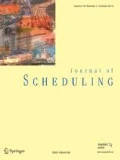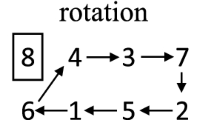Abstract
A fair schedule helps in improving the competitiveness and attractiveness of sports tournaments and in turn contributes positively to the sports economy. Break minimization and carryover effects minimization are considered to be two important criteria of fairness in scheduling of compact round-robin tournaments, and most related research looks at these problems separately. Various studies have sought to minimize the carryover effects in tournaments so that the number of breaks per team does not exceed a specific level. This study, however, is the first effort to define an integrated problem that aims to minimize the carryover effects and the number of breaks simultaneously for round-robin tournaments. We first introduce the mathematical formulation for the problem, whose objective measures how well a schedule simultaneously performs with respect to the number of breaks and the carryover effects. We then develop a heuristic method for this computationally hard problem. Comparing our results with the previous literature and the current practices of some European leagues, we show that our method provides schedules with better objective function values.

Similar content being viewed by others
References
Anderson, I. (1999). Balancing carry-over effects in tournaments. In Quinn, K., Webb, B., Rowley, C., Holroyd, F. (Eds.) Combinatorial designs and their applications. CRC Press, 403, pp. 1–16.
Atan, T., & Çavdaroğlu, B. (2018). Minimization of rest mismatches in round robin tournaments. Computers and Operations Research, 99, 78–89.
Çavdaroğlu, B., & Atan, T. (2020). Determining matchdays in sports league schedules to minimize rest differences. Operations Research Letters, 48, 209–216.
de Werra, D. (1981). Scheduling in sports. In P. Hansen (Ed.), Studies on graphs and discrete programming (pp. 381–395). North-Holland.
Elf, M., Jünger, M., & Rinaldi, G. (2003). Minimizing breaks by maximizing cuts. Operations Research Letters, 31(5), 343–349.
Goossens, D., & Spieksma, F. C. (2012). Soccer schedules in Europe: An overview. Journal of Scheduling, 15(5), 641–651.
Guedes, A. C., & Ribeiro, C. C. (2011). A heuristic for minimizing weighted carry-over effects in round robin tournaments. Journal of Scheduling, 14(6), 655–667.
Günneç, D., & Demir, E. (2019). Fair-fixture: Minimizing carry-over effects in football leagues. Journal of Industrial and Management Optimization, 15(4), 1565–1577.
Januario, T., & Urrutia, S. (2016). A new neighborhood structure for round robin scheduling problems. Computers and Operations Research, 70, 127–139.
Januario, T., Urrutia, S., Ribeiro, C. C., & De Werra, D. (2016). Edge coloring: A natural model for sports scheduling. European Journal of Operational Research, 254(1), 1–8.
Kendall, G., Knust, S., Ribeiro, C. C., & Urrutia, S. (2010). Scheduling in sports: An annotated bibliography. Computers and Operations Research, 37, 1–19.
Kidd, M. (2010). A tabu-search for minimising the carry-over effect value of a round-robin tournament. Orion, 26(2), 3125–141.
Lambrechts, E., Ficker, A. M., Goossens, D., & Spieksma, F. C. (2018). Round-robin tournaments generated by the circle method have maximum carry-over. Mathematical Programming, 172(1–2), 277–302.
Miettinen, K. (1998). No-preference methods. Nonlinear multiobjective optimization (pp. 67–76). Boston: MA: Springer.
Miyashiro, R., & Matsui, T. (2006a). Minimizing the carry-over effects value in a round-robin tournament. In Proceedings of the 6th international conference on the practice and theory of automated timetabling, PATAT, pp. 460–463.
Miyashiro, R., & Matsui, T. (2005). A polynomial-time algorithm to find an equitable home-away assignment. Operations Research Letters, 33(3), 235–241.
Miyashiro, R., & Matsui, T. (2006). Semidefinite programming based approaches to the break minimization problem. Computers and Operations Research, 33, 1975–1982.
Russell, K. G. (1980). Balancing carry-over effects in round robin tournaments. Biometrika, 67(1), 127–131.
Trick, M. A. (2001). A schedule-then-break approach to sports timetabling. In Burke, E., Erben, W. (Eds.) International conference on the practice and theory of automated timetabling III, vol. 2239. Springer, Berlin, pp. 242–253.
van’t Hof, P., & Briskorn, D. (2010). Constructing fair round robin tournaments with a minimum number of breaks. Operations Research Letters, 38(6), 592–596.
Author information
Authors and Affiliations
Corresponding author
Additional information
Publisher's Note
Springer Nature remains neutral with regard to jurisdictional claims in published maps and institutional affiliations.
Appendices
Appendix
A schedule template for 16 teams
Table 14 provides a schedule template for the single round-robin tournament with 16 teams. The first team is the one who plays at home. The coe value is 330 and the number of breaks is 26 (1 team with no breaks, 6 teams with one break, 7 teams with two breaks, 2 team with three breaks). The occurrence of a break for a team is highlighted in bold.
B Schedule template for 18 teams
Table 15 provides a schedule template for the single round-robin tournament with 18 teams. The coe value is 418 and the number of breaks is 36 (4 teams with one break, 10 teams with two breaks, 4 teams with three breaks).
C Schedule template for 20 teams
Table 16 provides a schedule template for the single round-robin tournament with 20 teams. The coe value is 506 and the number of breaks is 44 (1 team with no breaks, 3 teams with one break, 8 teams with two breaks, 7 teams with three breaks, 1 team with four breaks).
Rights and permissions
About this article
Cite this article
Çavdaroğlu, B., Atan, T. Integrated break and carryover effect minimization. J Sched 25, 705–719 (2022). https://doi.org/10.1007/s10951-022-00744-8
Accepted:
Published:
Issue Date:
DOI: https://doi.org/10.1007/s10951-022-00744-8




